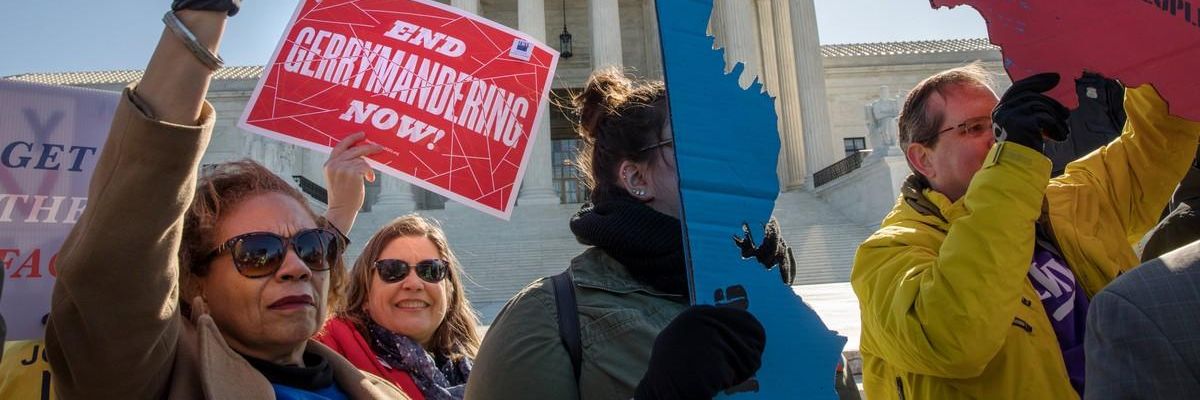The redrawing of congressional maps around the country has started in earnest, and there already are disturbing signs that communities of color will once again be squarely in the sights of map drawers. But Congress has the power to change this trajectory in a big way with the Freedom to Vote Act--the slimmed-down version of Democrats' omnibus democracy reform bill that Sen. Amy Klobuchar (D-MN) introduced on September 14, with support from Sen. Joe Manchin (D-WV), among others.
With Americans staring down the barrel of another round of aggressive gerrymandering, time is running short for Congress.
If passed by Congress, the legislation would put in place the most transformative changes to the redistricting process in the country's history, including banning partisan gerrymandering, strengthening other protections for communities of color, and making it easier for voters to get bad maps quickly struck down in court.
On the other hand, if Congress fails to act, expect more maps like the one released by Texas Republicans in late September. That map not only would fail to create any new electoral opportunities for the communities of color that provided 95 percent of Texas' population gain last decade, it actually would go backwards, dismantling several diverse districts in regions where multiracial coalitions have enjoyed increasing political success in recent years.
Time is of the essence. Every day that passes increases the risk that communities of color will bear the brunt of a brutal redistricting cycle, with fallout that could be decades long.
There are three key ways the Freedom to Vote Act would fix a broken redistricting process.
A strong ban on partisan gerrymandering
At the core of the bill's redistricting reforms is a robust statutory ban on partisan gerrymandering in the drawing of congressional maps that could be brought in federal court in Washington, D.C.. This ban would fill the gaping hole left in 2019 when the Supreme Court held that federal courts had no power to decide partisan gerrymandering claims asserted under the U.S. Constitution, leaving the policing of gerrymandering instead to Congress and the states.
A ban on partisan gerrymandering is a crucial protection for communities of color. Whether gerrymanderers are Democrats or Republicans, the targeting of communities of color is often the key to creating a map that favors one party over the other. This cycle, map drawers in Texas and other southern states are already defending racially discriminatory maps on the basis that the maps were drawn on a supposedly "color blind" basis and target Democrats rather than Black, Latino, and Asian voters--even though map drawers are fully aware that their maps invariably dilute the power of communities of color.
Under the Freedom to Vote Act, it would be easy to block the worst gerrymanders. If a map produces statistically high partisan bias using results of the last two presidential and last two Senate elections in a state, it is presumed to be illegal and cannot be used until a state establishes before a three-judge panel in Washington that no fairer map was possible.
Added protections for communities of color
In addition to banning partisan gerrymandering, the Freedom to Vote Act would also enhance protections for communities of color in redistricting by increasing the number of ways that communities can show their vote is being diluted and protecting the ability of minority groups to form coalitions with one another.
As evidenced by proposed Texas maps, many of this decade's most vicious redistricting attacks on communities of color are likely to be in the increasingly diverse suburbs of cities like Dallas, Houston, and Atlanta, where growing Latino, Black, and Asian communities are upending the status quo by coming together in multiracial coalitions to win or contest for power.
When voting rights laws were written in the 1960s, the country was both more starkly segregated and much less multiracial. The Freedom to Vote Act would update redistricting law to keep up with the more diverse and multiracial and multiethnic world of today, where most people of color in metro regions now live not in segregated cities but in cross-cultural, melting-pot suburbs.
Faster and easier litigation of redistricting cases
Last but not least, the Freedom to Vote Act would make it far easier for voters to challenge bad maps in court and win changes.
At present, redistricting cases can take years to litigate, during which time discriminatory maps continue to be used in election after election. In Florida, North Carolina, Texas, Virginia, litigation over maps took the better part of the last decade to resolve.
Under the Freedom to Vote Act, redistricting litigation would be streamlined in multiple ways. Both trial and appeals courts would be required to expedite redistricting cases. Courts, moreover, would be instructed to have a preliminary map ready to go once appeals are finished, rather than waiting for the end of the process to begin the development of a new map as is often the current practice. And if trial proceedings or appeals take a long time to fully resolve, courts are directed to put a temporary map in place to address egregious violations while the rest of the case is being litigated.
Finally, rather than being channeled into the Supreme Court, where the appellate process can be lengthy and delayed, appeals in redistricting cases would be centralized in the DC Circuit Court of Appeals, where a three-judge panel can resolve them more expeditiously.
With Americans staring down the barrel of another round of aggressive gerrymandering, time is running short for Congress. It's critical that the Freedom to Vote Act becomes law without delay if the nation is to avoid another decade of skewed maps.

